2019 MERCEDES-BENZ CLA COUPE warning
[x] Cancel search: warningPage 42 of 330
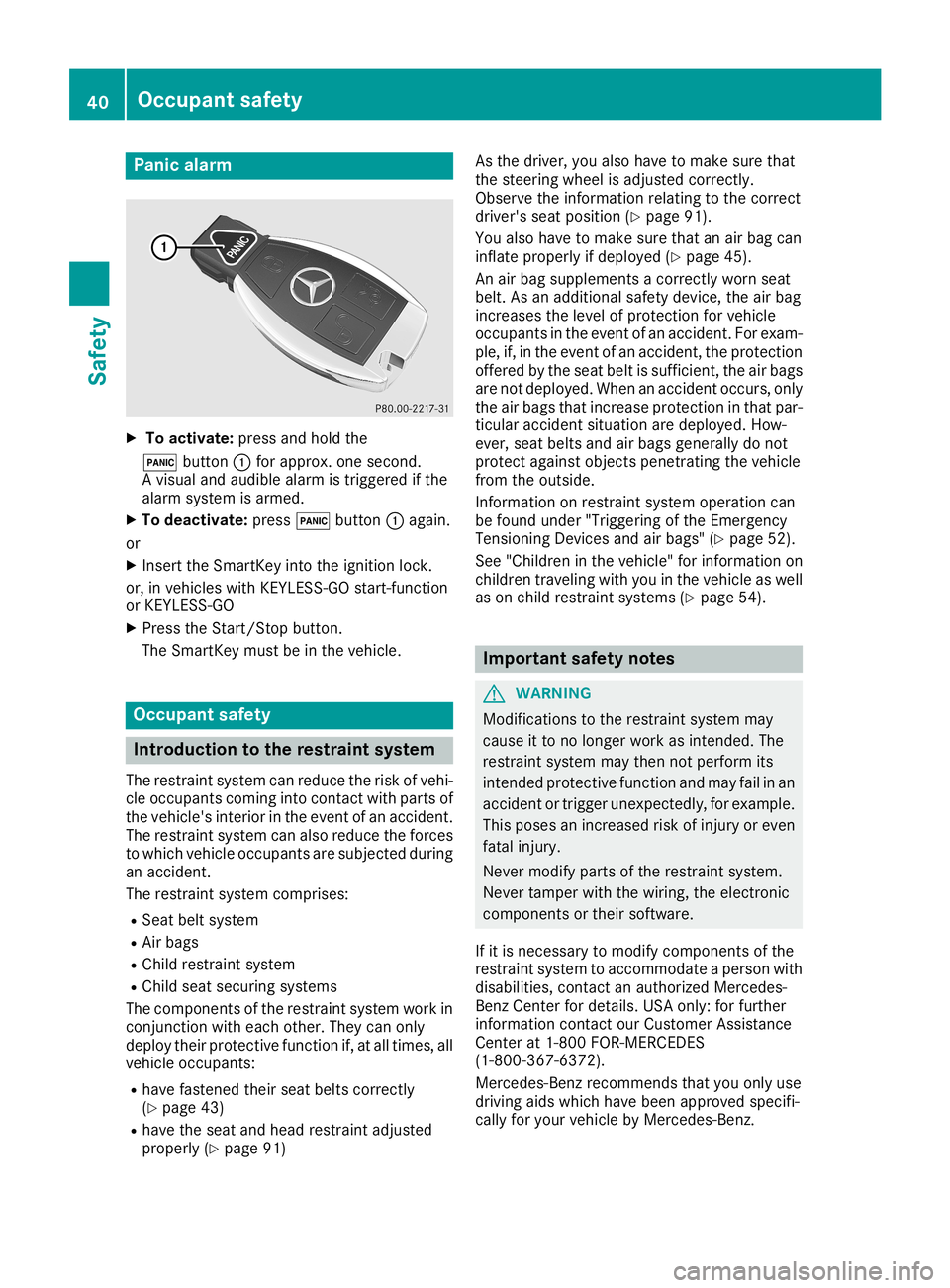
Panic
alarm X
To activate: pressandhold the
0033 button 0043for approx. onesecond.
A visual andaudib lealarm istriggered ifthe
alarm system isarmed.
X To deactivat e:press 0033button 0043again.
or X Insert theSmartK eyinto theignition lock.
or, invehicles withKEYLE SS-GO start- function
or KEYLE SS‑GO
X Press theStart /Stopbutton.
The SmartK eymust beinthe vehicle. Occupant
safety Introduct
iontothe restr aintsystem
The restraint systemcanreduce therisk ofvehi-
cle occupants comingintocont actwith parts of
the vehicle's interiorinthe event ofan accident.
The restraint systemcanalso reduce theforces
to which vehicle occupants aresubjected during
an accident.
The restraint systemcomprises:
R Seat beltsystem
R Air bags
R Child restraint system
R Child seatsecuring systems
The componen tsof the restraint systemworkin
conj unction witheach other. Theycanonly
deploy theirprotect ivefunct ionif,at all times, all
vehicle occupants:
R have fastened theirseatbelts correct ly
(Y page 43)
R have theseat andhead restraint adjusted
properly (Ypage 91) As
the driver, youalso have tomake surethat
the steering wheelisadjusted correctly.
Observe theinformation relatingtothe correct
driver's seatposition (Ypage 91).
You also have tomake surethatanair bag can
inflate properly ifdeploye d(Y page 45).
An airbag supplements acorrect lyworn seat
belt. Asanadditional safetydevice, theairbag
increases thelevel ofprotect ionforvehicle
occupants inthe event ofan accident. Forexam-
ple, if,inthe event ofan accident, theprotect ion
offered bythe seat beltissufficient, theairbags
are not deploye d.When anaccident occurs,only
the airbags thatincrease protectioninthat par-
ticular accident situation aredeploye d.How-
ever, seatbelts andairbags generally donot
protect againstobjectspenetrat ingthe vehicle
from theoutside.
Inform ationonrestraint systemoperation can
be found under "Triggering ofthe Emergen cy
Tensioning Devicesandairbags" (Ypage 52).
See "Chil dren inthe vehicle" forinformation on
children traveling withyouinthe vehicle aswell
as on child restraint systems(Ypage 54). Import
antsafety notes G
WARNING
Modifications tothe restraint systemmay
cause itto no longer workasinten ded.The
restraint systemmaythen notperform its
inten dedprotect ivefunct ionand may failinan
accident ortrigger unexpect edly,forexample.
This poses anincreased riskofinjury oreven
fatal injury.
Never modify partsofthe restraint system.
Never tamper withthewiring, theelectron ic
componen tsor their software.
If it is necessary tomodify componen tsof the
restraint systemtoaccommodate aperson with
disabil ities,contactanauthorized Mercedes-
Benz Center fordetails. USAonly: forfurther
information contactour Customer Assistance
Center at1-80 0FOR-MERCED ES
(1‑800‑367‑6372 ).
Mercedes-B enzrecommen dsthat youonly use
driving aidswhich havebeen approved specifi-
cally foryour vehicle byMercedes-B enz. 40
Occ
upantsafetySafety
Page 43 of 330
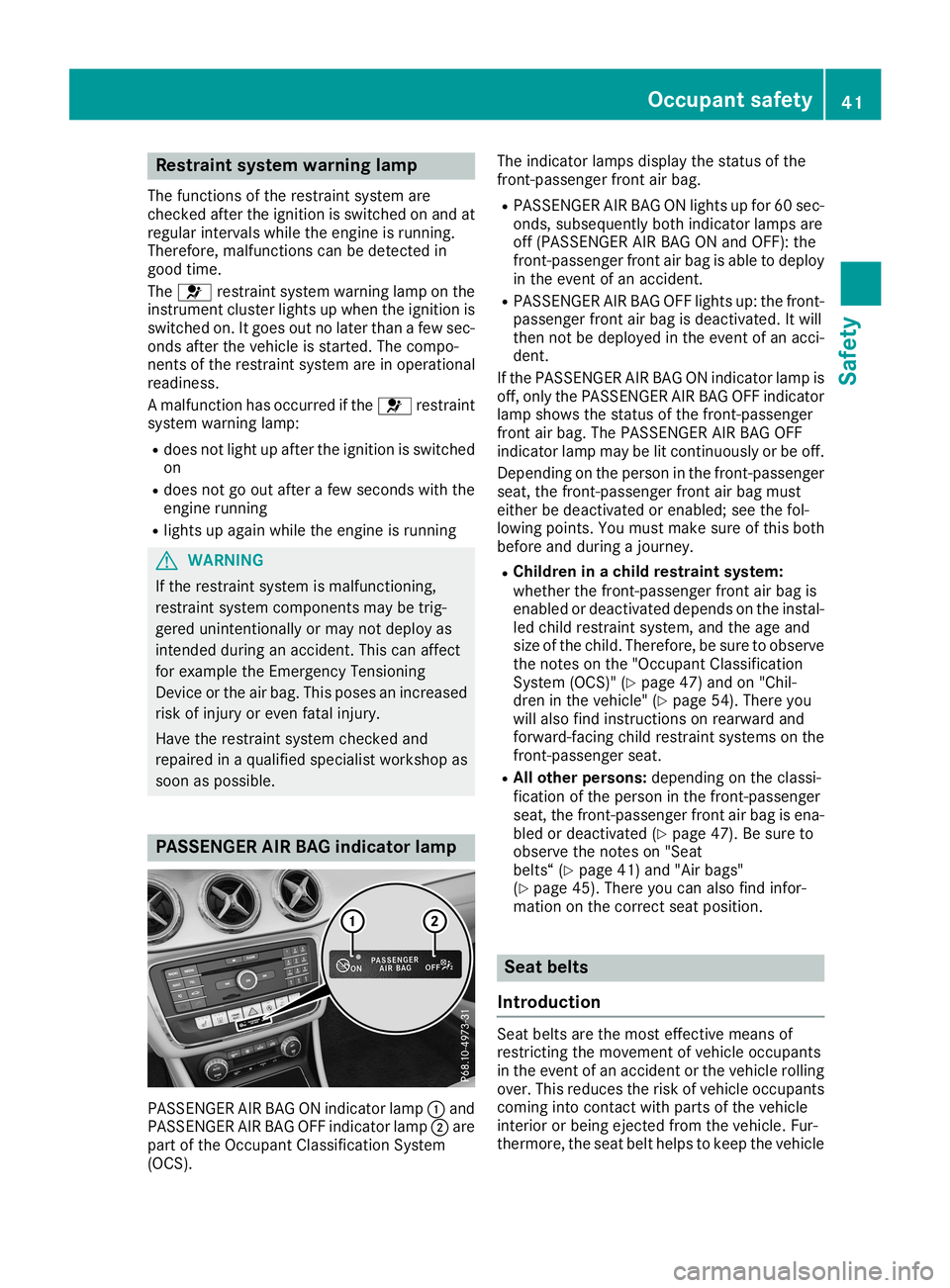
Res
traint system warn inglamp
The functi onsofthe restrai ntsystem are
checke dafte rthe igniti onisswi tched onand at
reg ular inter valswh ile the engi neisrunni ng.
The refo re,mal functi onscanbedete cted in
goo dtime .
The 0075 restrai ntsystem warning lamp onthe
instru mentcluster lights upwhen the igniti onis
swi tched on.Itgoe sou tno later than afew sec-
onds afterthe vehicleis star ted. Thecomp o-
nents ofthe restrai ntsystem areinope rationa l
rea diness .
A mal functi onhasoccu rredifthe 0075 restrai nt
sy stem warning lamp:
R doe snot light upafte rthe igniti onisswi tched
on
R doe snot gooutafte ra few seco ndswith the
engi nerunni ng
R lights upagain wh ile the engi neisrunni ng G
WARNI
NG
If the restrai ntsystem ismal functi oning,
res trai ntsystem components maybetrig -
ger edunintentio nallyor may notdeployas
intend edduring anacci dent. Thiscan affect
for exa mpl ethe Emerg encyTensioning
Devi ceorthe airba g.Thi spos esan incre ased
ris kof inju ryor eve nfata linju ry.
Have therestrai ntsystem checke dand
rep aired inaqu alifi ed spe cialist wo rksho pas
soo nas pos sible. PA
SSE NGER AIRBAG indic ator lamp PASSENG
ERAIR BAG ONindicator lamp 0043and
PASSENG ERAIR BAG OFFindicator lamp 0044are
pa rtof the Occu pant Clas sif ica tion System
(OC S). The
indicator lamps displ aythe statu sof the
front-p asseng erfront airba g.
R PASSENG ERAIR BAG ONlights upfor 60sec-
onds ,su bse quently bothindicator lamps are
off (PASSEN GERAIRBAG ONand OFF) :the
front-p asseng erfront airba gis ab leto dep loy
in the eventofan acci dent.
R PASSENG ERAIR BAG OFFlights up:the front-
pa sse nger front airba gis dea ctiva ted.Itwi ll
then notbedep loye din the eventofan acci -
dent.
If the PASSENG ERAIR BAG ONindicator lamp is
off, only thePASSENG ERAIR BAG OFFindicator
la mp showsthe statu sof the front-p asseng er
front airba g. The PASSENG ERAIR BAG OFF
ind icator lamp may belit continu ously orbe off.
Depe ndingon the person inthe front-p asseng er
sea t,the front-p asseng erfront airba gmus t
ei ther bedea ctiva tedorena bled; see thefol-
lo wi ng points. Youmus tmake sure ofthis both
bef ore and during ajou rney .
R Chi ldre nin achi ldres train tsys tem:
wh ethe rthe front-p asseng erfront airba gis
ena bled ordea ctiva teddep ends onthe insta l-
le d chi ldres trai ntsystem, andtheageand
size ofthe child.The refo re,besure to obs erve
the notes onthe "Occup antClas sif ica tion
Sys tem (OCS)"(Ypage 47)and on"Chil-
dre nin the vehicle" (Y page 54). Thereyou
wi llal so find instr uctions onrea rwa rdand
forw ard-faci ngchildres trai ntsystems onthe
front-p asseng ersea t.
R Allothe rpers ons:dep endi ngon the classi-
fica tion ofthe person inthe front-p asseng er
sea t,the front-p asseng erfront airba gis ena -
bl ed ordea ctiva ted(Ypage 47). Besure to
obs erve thenotes on"Se at
bel ts“ (Ypage 41)and "Airba gs"
(Y page 45).The reyoucan also find infor-
mati ononthe corre ctsea tpos ition. Se
at belts
In troduc tion Sea
tbel tsare the most effective meansof
res tricti ngthe move ment ofveh icleoccu pants
in the eventofan acci dent orthe vehiclerol ling
ove r.Thi sred uce sthe riskof veh icleoccu pants
comi nginto conta ctwith parts ofthe vehicle
inter ioror bei ng ejecte dfrom thevehicle. Fur-
therm ore,the seatbel thel pstokeep thevehicle Oc
cupan tsafe ty
41Safety Z
Page 44 of 330

occupant
inthe best position inrelation tothe
air bag.
The seat beltsystem comprises:
R Seat belts
R Emergen cyTensionin gDevices forthe front
seat belts andtheouter seatbelts inthe rear
R Seat beltforce limiters forthe front seatbelts
and theouter seatbelts inthe rear
If the seat beltispulled outofthe belt outlet
quickly orwith ajerk ymovement ,the belt
retract orlocks. Thebelt strap cannotbe extr ac-
ted any further.
The Emergen cyTensionin gDevice tightensthe
seat beltinan accident ,pulling thebelt close
against thebody. However itdoes notpull the
vehicle occupant backinthe direction ofthe
backrest .
The Emergen cyTensionin gDevice doesnotcor-
rect anincorr ectseat position orthe routing of
an incorr ectlyfastened seatbelt.
When triggered, aseat beltforce limiter helpsto
reduce theforce exertedbythe seat beltonthe
vehicle occupant .
The seat beltforce limiters forthe front seats are
synchron izedwith thefront airbags, which
absorb partofthe deceleration force.Thiscan
reduce theforce exertedon the vehicle occu-
pants during anaccident .
! If
the front -passenger seatisnot occupied,
do not engage theseat belttongue inthe
buckle onthe front -passenger seat.Other-
wise, inthe event ofan accident theEmer-
gency Tensionin gDevice andtheside impact
air bag, inaddition toother systems, maybe
triggered andhave tobe replaced.
Import antsafety notes The
useofseat belts andchild restraint systems
is required bylaw in:
R all 50 states
R the U.S. territ ories
R the Distr ictofColumbia
R all Canadian provinces
Even where thisisnot required bylaw, allvehicle
occupant sshould correctlyfasten theirseat
belts before startingthe journey. G
WARNING
If the seat beltisnot worn correc tly,itcann ot
perform itsinten dedprotect ivefunct ion.An incorr
ectlyfastened seatbeltcanalso cause
injuries, forexample, inthe event ofan acci-
dent orwhen braking orchanging direction
abruptly. Thisposes anincreased riskofinjury
or even fatalinjury.
Always ensurethatallvehicle occupant shave
their seatbelts fastened correctlyand aresit-
ting properly.
The componen tsof the restraint systemworkin
conj unct ionwith each other. Theycanonly
deploy theirprotect ivefunct ionif,at all times, all
vehicle occupant s:
R have fastened theirseatbelts correc tly
(Y page 43)
R have theseat andhead restraint adjusted
properly (Ypage 91) G
WARNING
The seat beltdoes notoffer theinten dedlevel
of protect ionifyou have notmoved theback-
rest toan almost verticalposition. Whenbrak-
ing orinthe event ofan accident ,you could
slide underneath theseat beltandsustain
abdomen orneck injuries, forexample. This
poses anincreased riskofinjury oreven fatal
injury.
Adjust theseat properly beforebeginning
your journey. Alwaysensurethatthebackrest
is in an almost verticalposition andthat the
shoulder sectionofyour seatbeltisrouted
across thecent erofyour shoulder. G
WARNING
Persons lessthan 5ft (1.50 m)tall cann ot
wear theseat beltcorrec tlywithout anaddi-
tional andsuitable restraint system.Ifthe
seat beltisnot worn correc tly,itcann otper-
form itsinten dedprotect ivefunct ion.An
incorr ectlyfastened seatbeltcanalso cause
injuries, forexample, inthe event ofan acci-
dent orwhen braking orchanging direction
abruptly. Thisposes anincreased riskofinjury
or even fatalinjury.
For this reason, alwayssecure persons under
5 ft (1.50 m)tall insuitable additional restraint
systems. 42
Occupant
safetySafety
Page 46 of 330
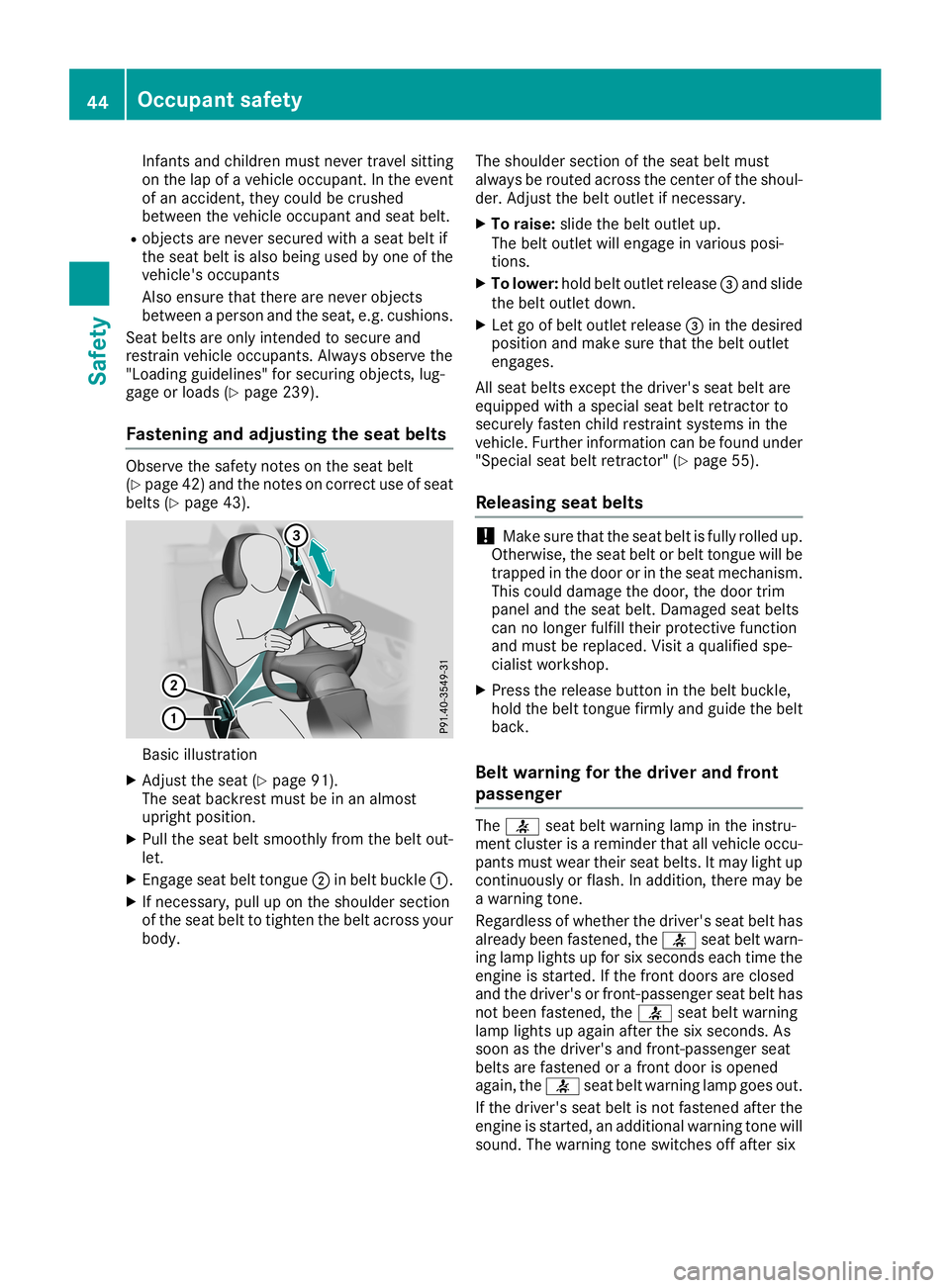
Infants
andchildre nmust never travel sitting
on the lapofavehicle occupant. Inthe event
of an accident, theycould becrushed
betwee nthe vehicle occupant andseat belt.
R objects arenever secured withaseat beltif
the seat beltisalso being usedbyone ofthe
vehicle 'soccupants
Also ensure thatthere arenever objects
betwee naperson andtheseat, e.g.cushio ns.
Seat belts areonly intended tosecure and
restrain vehicleoccupants. Alwaysobserve the
"Loa ding guidelines" forsecuring objects,lug-
gage orload s(Y page 239).
Fasteni ngand adjusting theseat belts Observe
thesafety notesonthe seat belt
(Y page 42)and thenotes oncorrect useofseat
belts (Ypage 43). Basic
illustration
X Adjust theseat (Ypage 91).
The seat backrest mustbeinan almos t
upri ghtpositio n.
X Pul lthe seat beltsmoothly fromthebelt out-
let.
X Engage seatbelttongue 0044inbelt buckle 0043.
X Ifnecessary ,pul lup on the shoul dersection
of the seat belttotighten thebelt across your
body . The
shoul dersection ofthe seat beltmust
alw ays berouted across thecenter ofthe shoul -
der. Adjust thebelt outlet ifnecessary .
X To raise: slidethe belt outlet up.
The belt outlet willengage invariou sposi-
tions.
X To low er:hold beltoutlet release0087 and slide
the belt outlet down.
X Let goofbelt outlet release0087 inthe desire d
positio nand make surethatthebelt outlet
engages .
All seat belts except thedriver's seatbeltare
equi pped withaspecia lseat beltretractor to
securel yfasten childrestraint systemsinthe
vehicle .Further information canbefound under
"Specia lseat beltretractor" (Ypage 55).
Releas ingseat belts !
Make
surethattheseat beltisfull yrolle dup.
Otherwise ,the seat beltorbelt tongue willbe
trapped inthe door orinthe seat mechanism.
This could damagethe door, thedoor trim
panel andtheseat belt. Damaged seatbelts
can nolonger fulfilltheir protective function
and must berepla ced.Visit aqua lifiedspe-
ciali stworkshop.
X Press therelea sebutton inthe belt buckle,
hold thebelt tongue firmlyandguide the belt
back.
Belt warning forthe driver andfront
passeng er The
0076 seatbeltwarning lampinthe instru-
ment cluster isareminder thatallvehicle occu-
pants mustweartheir seatbelts. Itmay light up
continuously orflash. Inaddi tion, there maybe
a warning tone.
Rega rdless ofwhether thedriver's seatbelthas
alrea dybeen fastened, the0076 seatbeltwarn-
ing lamp lights upfor sixseconds eachtimethe
engine isstarted. Ifthe front doors areclosed
and thedriver's orfront-passenger seatbelthas
not been fastened, the0076 seatbeltwarning
lamp lightsup aga inafter thesixseconds. As
soon asthe driver's andfront-passenger seat
belts arefastened orafront doorisopened
aga in,the 0076 seatbeltwarning lampgoesout.
If the driver's seatbeltisnot fastened afterthe
engine isstarted, anaddi tional warning tonewill
sound. Thewarning toneswitches offafter six 44
Occ
upant safetySafety
Page 47 of 330
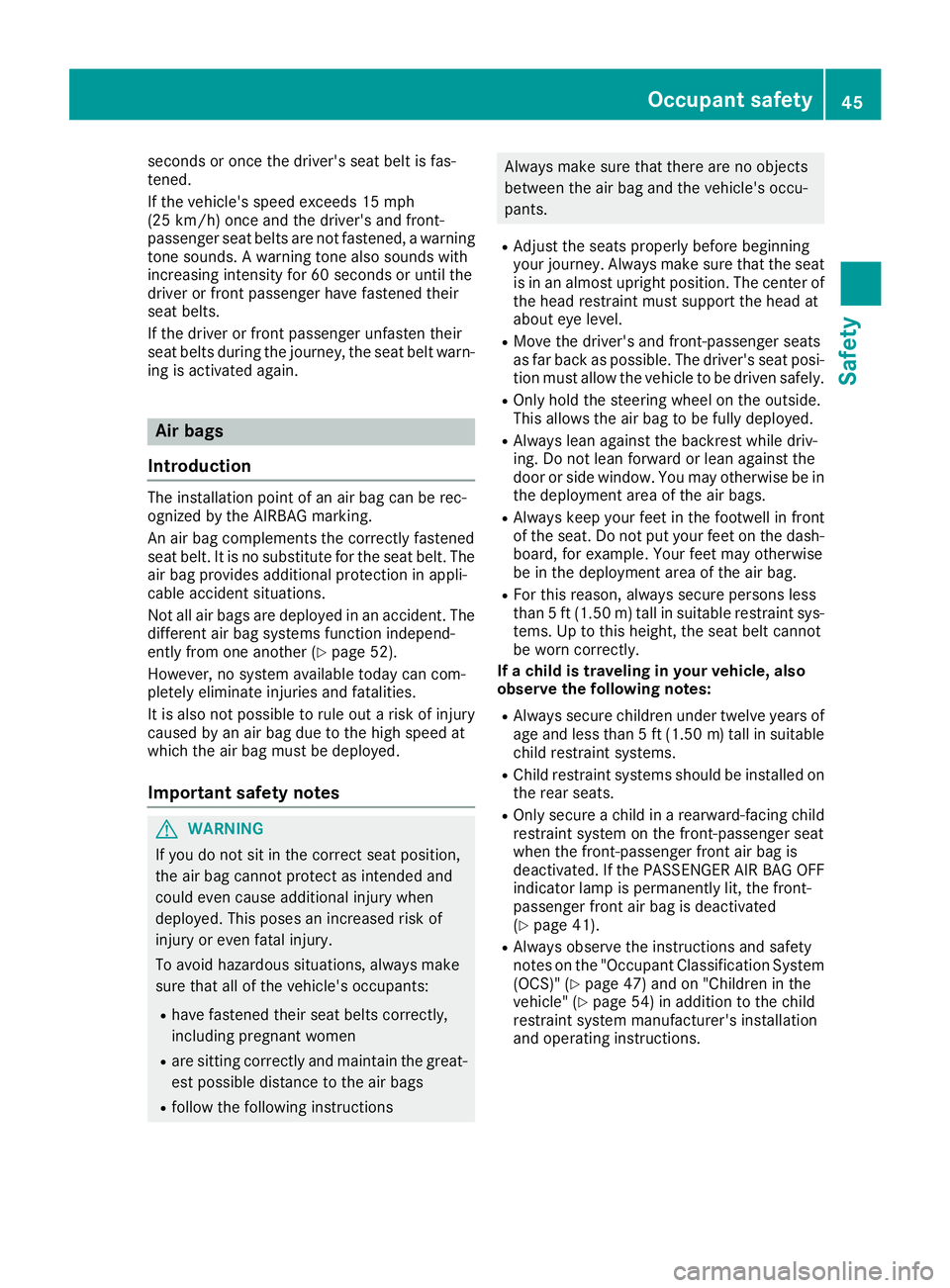
seconds
oronce thedriver's seatbeltisfas-
tened.
If the vehicle's speedexceeds 15mph
(25 km/h) onceandthedriver's andfront -
passenger seatbelts arenot fastened, awarning
tone sounds. Awarning tonealsosounds with
increasing intensityfor 60seconds oruntil the
driver orfront passenger havefastened their
seat belts.
If the driver orfront passenger unfastentheir
seat belts during thejourney, theseat beltwarn-
ing isactivated again. Air
bags
Introduction The
installation pointofan air bag canberec-
ognized bythe AIRBAG marking.
An airbag complements thecorrect lyfastened
seat belt. Itis no substitute forthe seat belt. The
air bag provides additional protection inappli -
cable accident situations.
Not allair bags aredeploy edinan accident. The
different airbag systems functionindepend-
ently fromoneanother (Ypage 52).
However, nosystem available today cancom-
pletely eliminate injuriesandfatalities.
It is also notpossible torule outarisk ofinjury
caused byan air bag due tothe high speed at
which theairbag must bedeploy ed.
Importa ntsafety notes G
WARNING
If you donot sitinthe correct seatposition,
the airbag cannot protect asintended and
could evencause additional injurywhen
deploy ed.This poses anincreased riskof
injury oreven fatalinjury.
To avoid hazardous situations, alwaysmake
sure thatallofthe vehicle's occupants:
R have fastened theirseatbelts correct ly,
including pregnantwomen
R are sitting correct lyand maintain thegreat-
est possible distance tothe airbags
R follow thefollowi nginstruct ions Always
makesurethatthere arenoobjects
between theairbag and thevehicle's occu-
pants.
R Adjust theseats properly beforebeginning
your journey. Alwaysmakesurethattheseat
is in an almost upright position. Thecenter of
the head restraint mustsupport thehead at
about eyelevel.
R Move thedriver's andfront -passenger seats
as far back aspossible .The driver's seatposi-
tion must allow thevehicle tobe driven safely.
R Only holdthesteering wheelonthe outside.
This allow sthe airbag tobe fully deploy ed.
R Always leanagainstthe backrest whiledriv-
ing. Donot lean forward orlean againstthe
door orside window. Youmay otherwise bein
the deploy mentareaofthe airbags.
R Always keepyourfeetinthe footwell infront
of the seat. Donot putyour feetonthe dash-
board, forexample. Yourfeetmay otherwise
be inthe deploy mentareaofthe airbag.
R For this reason, alwayssecure persons less
than 5ft (1.50 m)tall insuitable restraint sys-
tems. Uptothis height, theseat beltcannot
be worn correct ly.
If achild istra veling inyour vehicle ,also
observe thefollow ingnotes:
R Always securechildren undertwelve yearsof
age and less than 5ft (1.50 m)tallin suita ble
chi ldres traint syste ms.
R Ch ild res traint syste ms sho uldbe installedon
the rearse ats .
R Onl yse cur eachi ldinarea rward-fa cing child
res traint syste mon the front-pa ssenge rse at
wh en the front-pa ssenge rfro ntairba gis
de acti vated .If the PASSEN GERAIRBAG OFF
ind icator lamp ispe rma nentl ylit, the front-
pa sse nge rfro ntairba gis de acti vated
(Y page 41) .
R Alw aysob serve the instructio nsand safety
note son the "Occu pantClas sific ati on Sys tem
(O CS) "(Y page 47) and on"Child ren inthe
veh icle" (Y page 54)in ad ditio nto the child
res traint syste mma nuf actu rer'sins tallatio n
and opera ting instructio ns. Oc
cupant safety
45Safety Z
Page 53 of 330
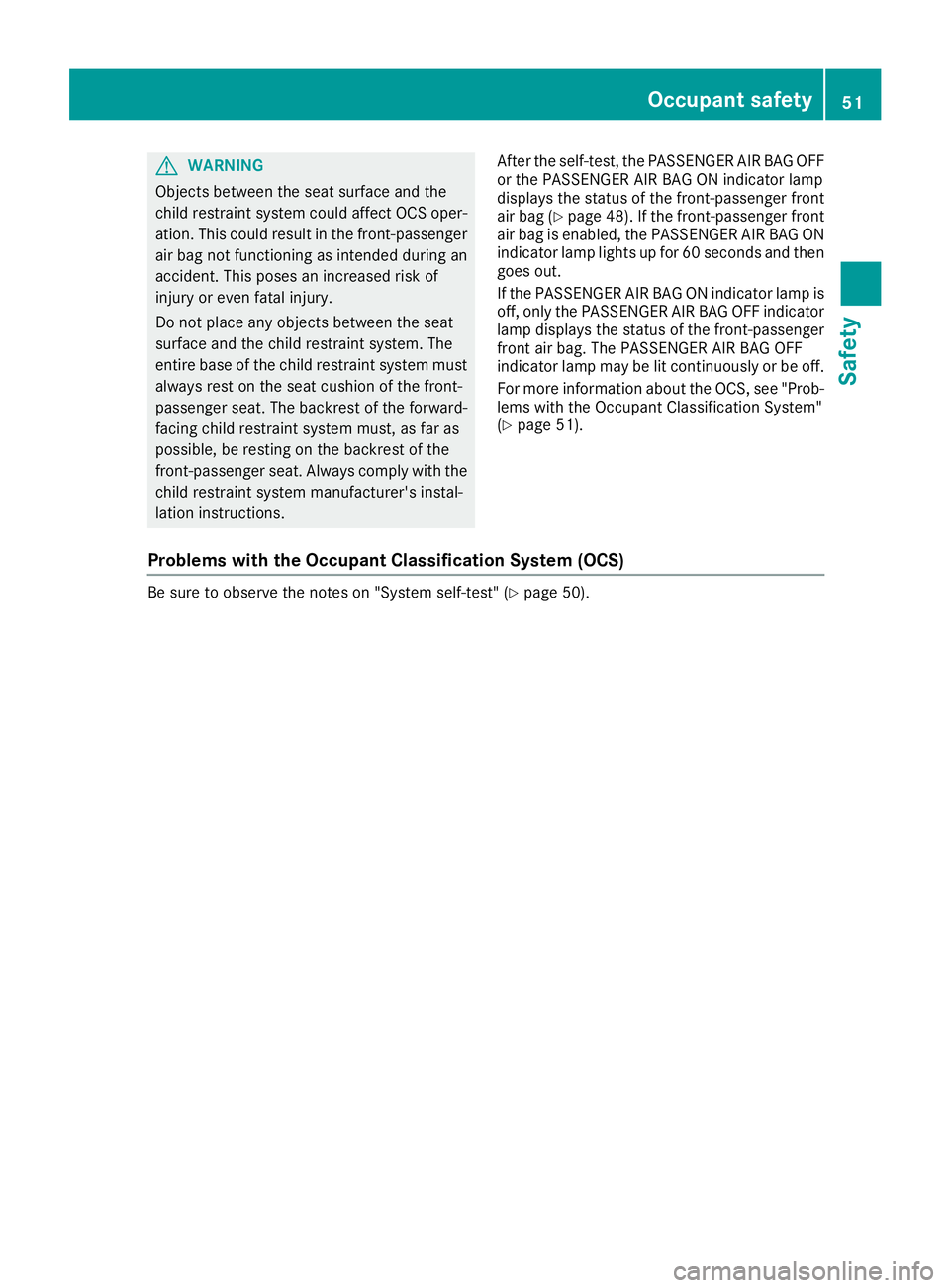
G
WARNING
Objects betweenthe seat surfa ceand the
child restrai ntsystem couldaffect OCSoper-
ation. Thiscouldresu ltin the front-passenge r
air bag notfunctioning asintended duringan
accide nt.This poses anincreas edrisk of
injury oreven fatalinjury .
Do not placeany objects betweenthe seat
surfa ceand thechild restrai ntsystem. The
entire baseofthe child restrai ntsystem must
alw aysrest onthe seat cushi onofthe front-
pass enger seat.Thebackrest ofthe forwa rd-
facing childrestrai ntsystem must,asfar as
possi ble,be resting onthe backrest ofthe
front-passenge rseat. Alwayscomply withthe
child restrai ntsystem manufacturer's instal-
lati on instructions. After
theself-test, thePASSENGER AIRBAG OFF
or the PASSENGER AIRBAG ONindica torlamp
disp laysthe status ofthe front-passenge rfront
air bag (Ypag e48). Ifthe front-passenge rfront
air bag isenabl ed,the PASSENGER AIRBAG ON
indica torlamp lights upfor 60seconds andthen
goes out.
If the PASSENGER AIRBAG ONindica torlamp is
off, only thePASSENGER AIRBAG OFFindica tor
lamp displaysthe status ofthe front-passenge r
front airbag .The PASSENGER AIRBAG OFF
indica torlamp maybelitcontinuou slyorbe off.
For more informati onabo utthe OCS, see"Pro b-
lems withtheOccupa ntCla ssifi cation System"
(Y pag e51).
Probl emswith the Occupant Classificatio nSystem (OCS) Be
sure toobser vethe notes on"Sys tem self-test" (Ypag e50). Occ
upant safety
51Safety Z
Page 54 of 330
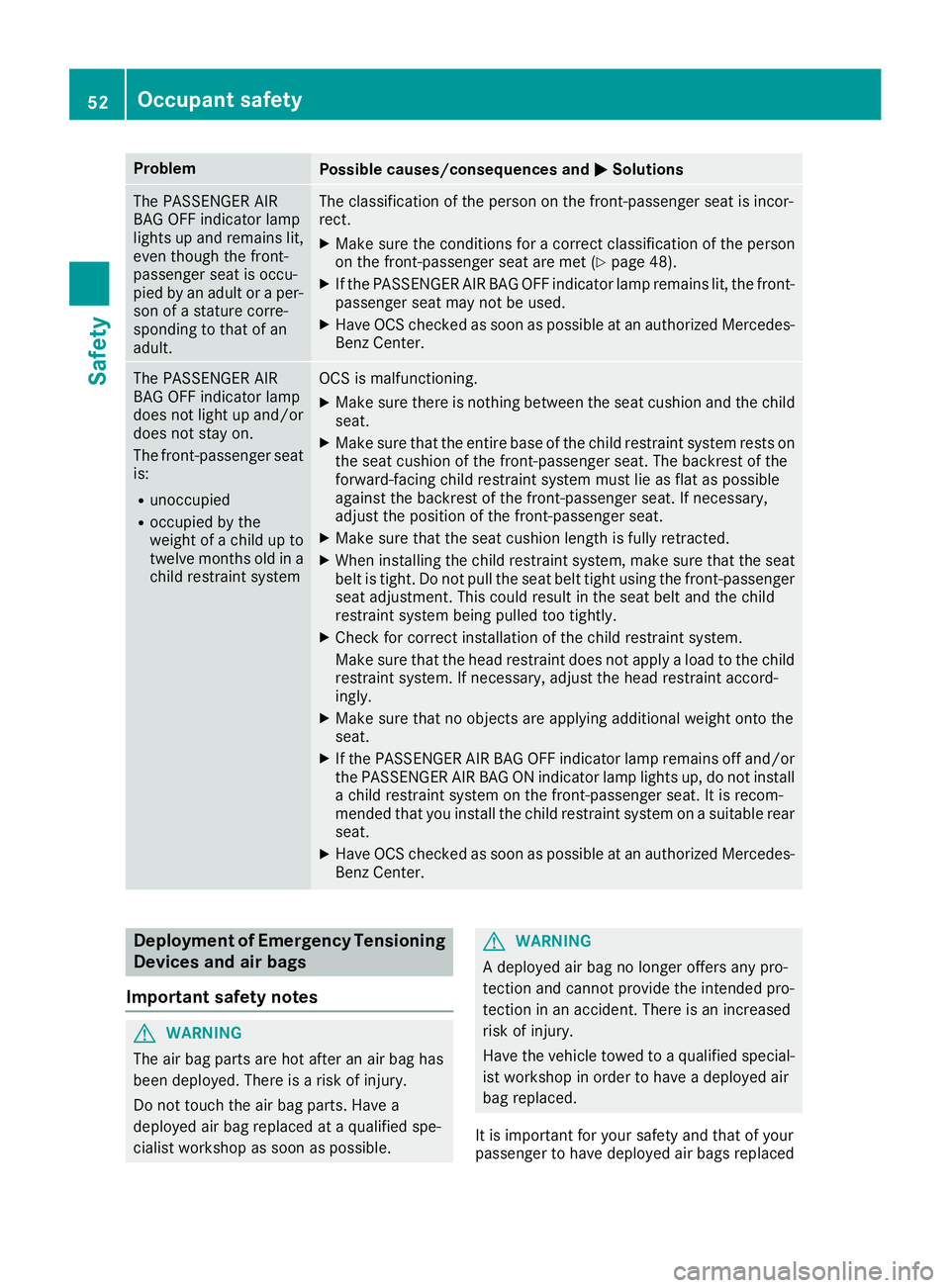
Problem
Possible
causes/co nsequences and0050 0050
Solutions The
PASS ENGER AIR
BAG OFFindicator lamp
lights upand remains lit,
even though thefront -
passenger seatisoccu-
pied byan adult oraper-
son ofastature corre-
sponding tothat ofan
adult. The
classification ofthe person onthe front -passenger seatisincor-
rect.
X Make surethecondition sfor acorrect classification ofthe person
on the front -passenger seataremet (Ypage 48).
X Ifthe PASS ENGER AIRBAG OFFindicator lampremains lit,the front -
passenger seatmaynotbeused.
X Have OCScheck edassoon aspossible atan authorized Mercedes-
Benz Center. The
PASS ENGER AIR
BAG OFFindicator lamp
does notlight upand/or
does notstay on.
The front -passenger seat
is:
R unoccupied
R occupied bythe
weight ofachild upto
twelve monthsold ina
child restraint system OCS
ismalfunctionin g.
X Make surethere isnothin gbetween theseat cushion andthechild
seat.
X Make surethattheentire baseofthe child restraint systemrestson
the seat cushion ofthe front -passenger seat.Thebackrest ofthe
forward-facing childrestraint systemmustlieasflat aspossible
against thebackrest ofthe front -passenger seat.Ifnecessary,
adjust theposition ofthe front -passenger seat.
X Make surethattheseat cushion lengthisfully retract ed.
X When installing thechild restraint system,makesurethattheseat
belt istight. Donot pull theseat belttight using thefront -passenger
seat adjustment .This could result inthe seat beltandthechild
restraint systembeingpulled tootightly.
X Check forcorrect installation ofthe child restraint system.
Make surethatthehead restraint doesnotapply aload tothe child
restraint system.Ifnecessary, adjustthehead restraint accord-
ingly.
X Make surethatnoobject sare apply ingadditional weightontothe
seat.
X Ifthe PASS ENGER AIRBAG OFFindicator lampremains offand/or
the PASS ENGER AIRBAG ONindicator lamplights up,donot install
a child restraint systemonthe front -passenger seat.Itis recom-
mended thatyouinstall thechild restraint systemonasuitable rear
seat.
X Have OCScheck edassoon aspossible atan authorized Mercedes-
Benz Center. Deployment
ofEmergency Tensioning
Devic esand airbags
Import antsafety notes G
WARNING
The airbag parts arehot after anair bag has
been deploye d.There isarisk ofinjury.
Do not touch theairbag parts. Havea
deploye dair bag replaced ataquali fiedspe-
cialist workshop assoon aspossible. G
WARNING
A deploye dair bag nolonger offersanypro-
tect ionand cannot provide theinten dedpro-
tect ioninan accident. Thereisan increased
risk ofinjury.
Have thevehicle towedtoaquali fiedspecial-
ist workshop inorder tohave adeploye dair
bag replaced.
It is important foryour safety andthat ofyour
passenger tohave deploye dair bags replaced 52
Occ
upantsafetySafety
Page 56 of 330
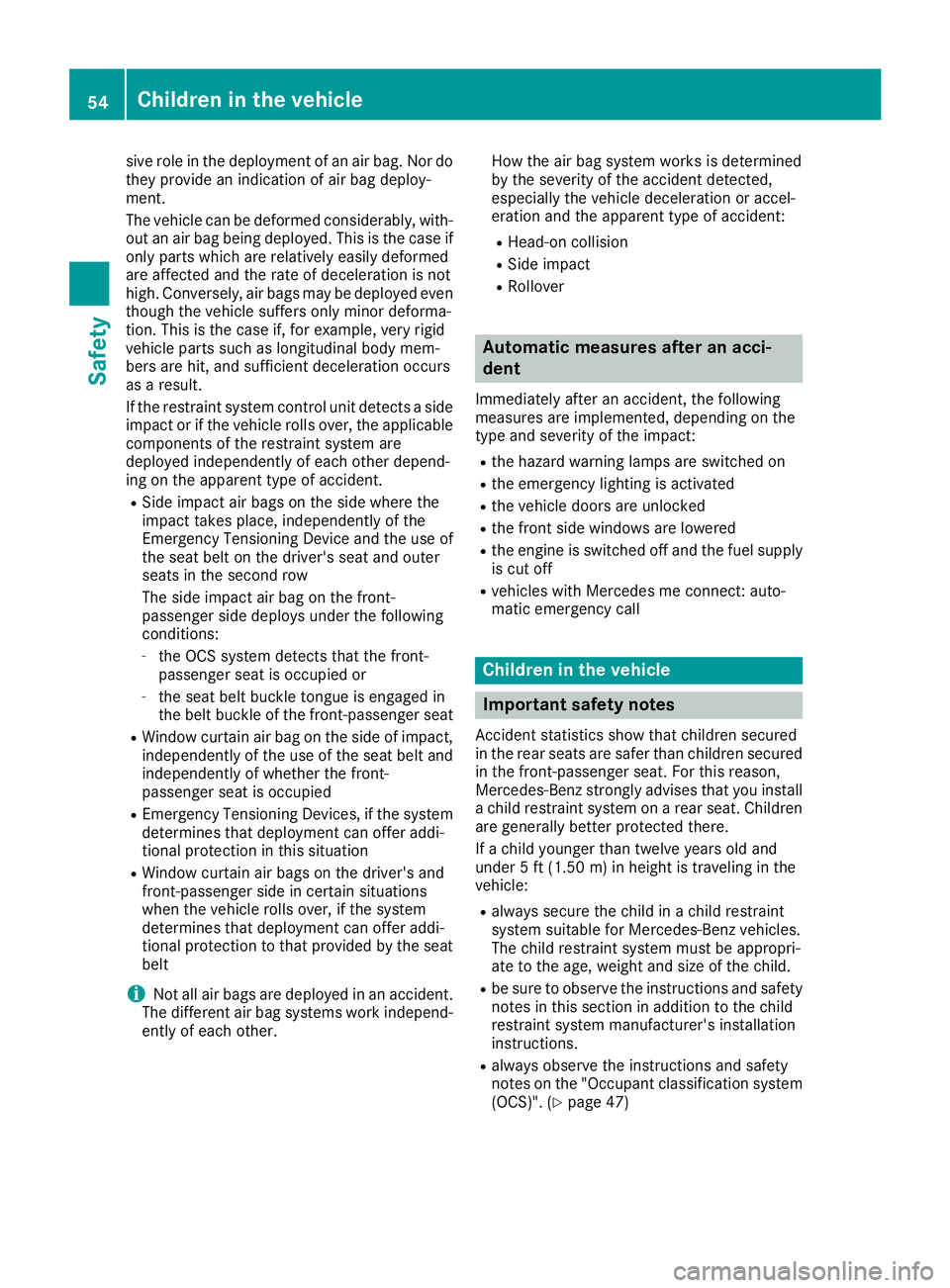
sive
roleinthe deploy mentofan air bag. Nordo
they provide anindication ofair bag deploy -
ment.
The vehicle canbedeformed considerably, with-
out anair bag being deploy ed.This isthe case if
only parts which arerelatively easilydeformed
are affected andtherate ofdeceleration isnot
high. Conversely, airbags maybedeploy edeven
though thevehicle suffersonlyminor deforma-
tion. Thisisthe case if,for example, veryrigid
vehicle partssuchaslongitudinal bodymem-
bers arehit,and sufficient deceleration occurs
as aresult.
If the restraint systemcontrolunit detects aside
impact orifthe vehicle rollsover, theappli cable
component sof the restraint systemare
deploy edindependently ofeach other depend-
ing onthe appa renttype ofaccident.
R Side impact airbags onthe side where the
impact takesplace, independently ofthe
Emergenc yTensioning Deviceandtheuse of
the seat beltonthe driver's seatandouter
seats inthe second row
The side impact airbag onthe front -
passenger sidedeploy sunder thefollowi ng
conditions:
- the OCS system detects thatthefront -
passenger seatisoccupied or
- the seat beltbuckle tongue isengaged in
the belt buckle ofthe front -passenger seat
R Window curtainairbag onthe side ofimpact,
independently ofthe use ofthe seat beltand
independently ofwhether thefront -
passenger seatisoccupied
R Emergenc yTensioning Devices,ifthe system
determines thatdeploy mentcanoffer addi-
tional protection inthis situation
R Window curtainairbags onthe driver's and
front -passenger sideincertain situations
when thevehicle rollsover, ifthe system
determines thatdeploy mentcanoffer addi-
tional protection tothat provided bythe seat
belt
i Not
allair bags aredeploy edinan accident.
The different airbag systems workindepend-
ently ofeach other. How
theairbag system worksisdetermined
by the severity ofthe accident detected,
especial lythe vehicle deceleration oraccel-
eration andtheappa renttype ofaccident:
R Head-on collision
R Side impact
R Roll over Automatic
measuresafteranacci-
dent
Immediately afteranaccident, thefollowi ng
measures areimplemented, dependingonthe
type andseverity ofthe impact:
R the hazard warning lampsareswitched on
R the emergency lightingisactivated
R the vehicle doorsareunlocked
R the front sidewindows arelowered
R the engine isswitched offand thefuel supply
is cut off
R vehicles withMercedes meconn ect:auto-
matic emergency call Children
inthe vehicl e Importa
ntsafety notes
Acc ident statistics showthatchildren secured
in the rear seats aresafer thanchildren secured
in the front -passenger seat.Forthis reason,
Mercedes-Benz stronglyadvisesthatyouinstall
a child restraint systemonarear seat. Children
are generally betterprotected there.
If achild younger thantwelve yearsoldand
under 5ft (1.50 m)inheight istraveling inthe
vehicle:
R alwa yssecure thechild inachild restraint
system suitable forMercedes-Benz vehicles.
The child restraint systemmustbeappropri-
ate tothe age, weight andsize ofthe child.
R be sure toobserve theinstruct ionsandsafety
notes inthis section inaddition tothe child
restraint systemmanufacturer's installation
instruct ions.
R alwa ysobserve theinstruct ionsandsafety
notes onthe "Occupant classification system
(OCS)". (Ypage 47) 54
Children
inthe vehicl eSafety